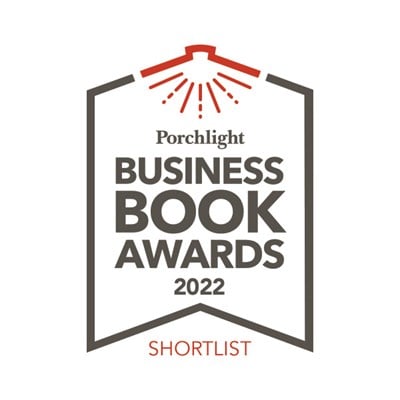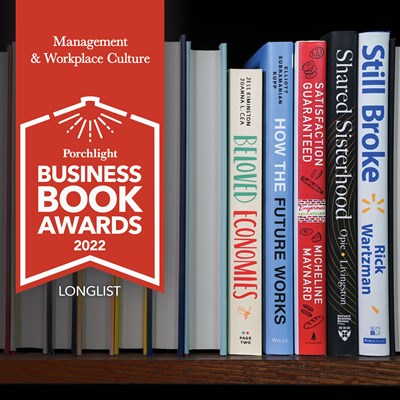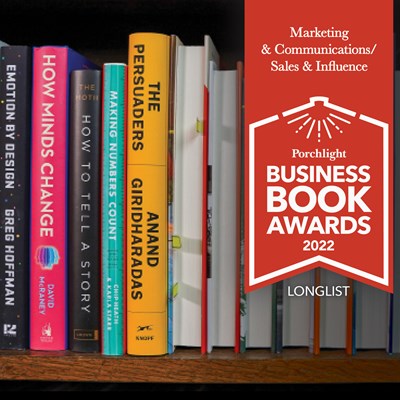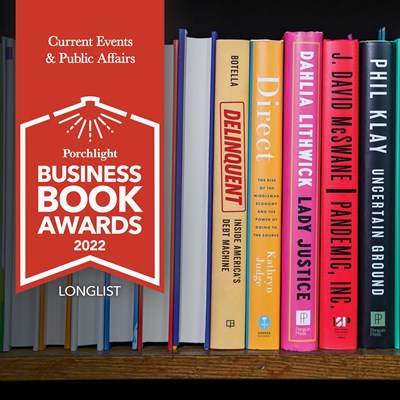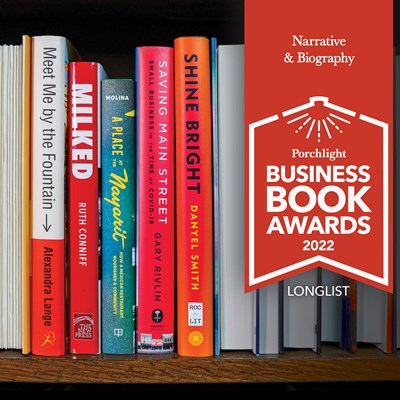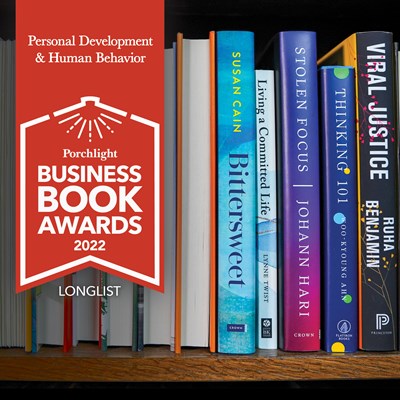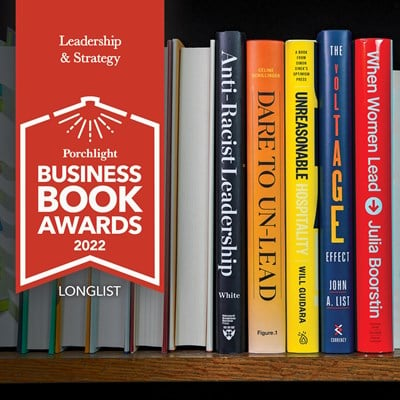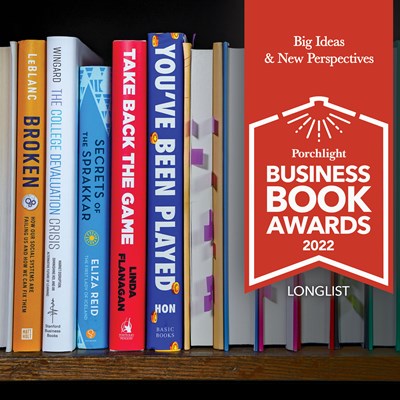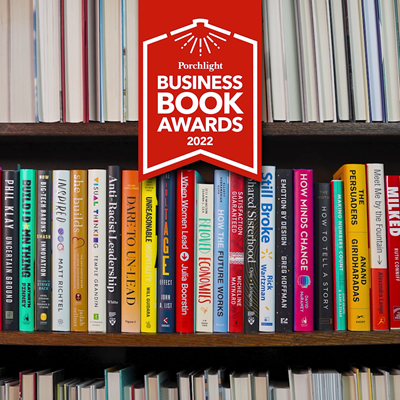Inside the 2022 Longlist | Innovation & Creativity
December 02, 2022
These five books will prompt you to ask questions about yourself and the world around you, and it is in this inner-searching and outward observation that we will find, innovate, and create a better world for us all.
According to the National Bureau of Economic Research, while the pandemic curbed business creation in the first few months of 2020, “the pace of [business] applications since mid-2020 is the highest on record.” But how do we get these businesses to stick around? As great as being your own boss and bringing your ideas to fruition can be, the hope brought by vaccines has ebbed and flowed throughout 2022, making business pivots a part of everyday life.
Running your own business can be a hard and lonely track, and you can hit a wall managing a side-hustle or exercising creativity in your free time. While more and more women and people of color are starting businesses, and our culture is becoming more empathetic and embracing of diversity (though sometimes it doesn’t feel like it), there is still a need for greater representation of diversity in our media, our workplaces, education, and leadership. These five books are a good place to begin to fill that need.
The stars of this year’s Innovation & Creativity books are humans who connect creativity to inclusivity to adaptability and to humanity. The entrepreneurs and authors highlighted are unique, yes, but they also share traits and lived experiences with many others who have been underrepresented in the innovation space. I hope their work speaks to you and/or reflects you, too.
Reading multiple books on this list will strengthen your sense of wonder and expand the meaning of "normal.” They will educate you on the current state of innovation and encourage you to think more critically. They will convince you that creativity is within each of us and that, together, we can innovate more intentionally and better support the economy, our communities, and each other. They will prompt you to ask questions about yourself and the world around you, and it is in this inner-searching and outward observation that we will find, innovate, and create a better world for us all.
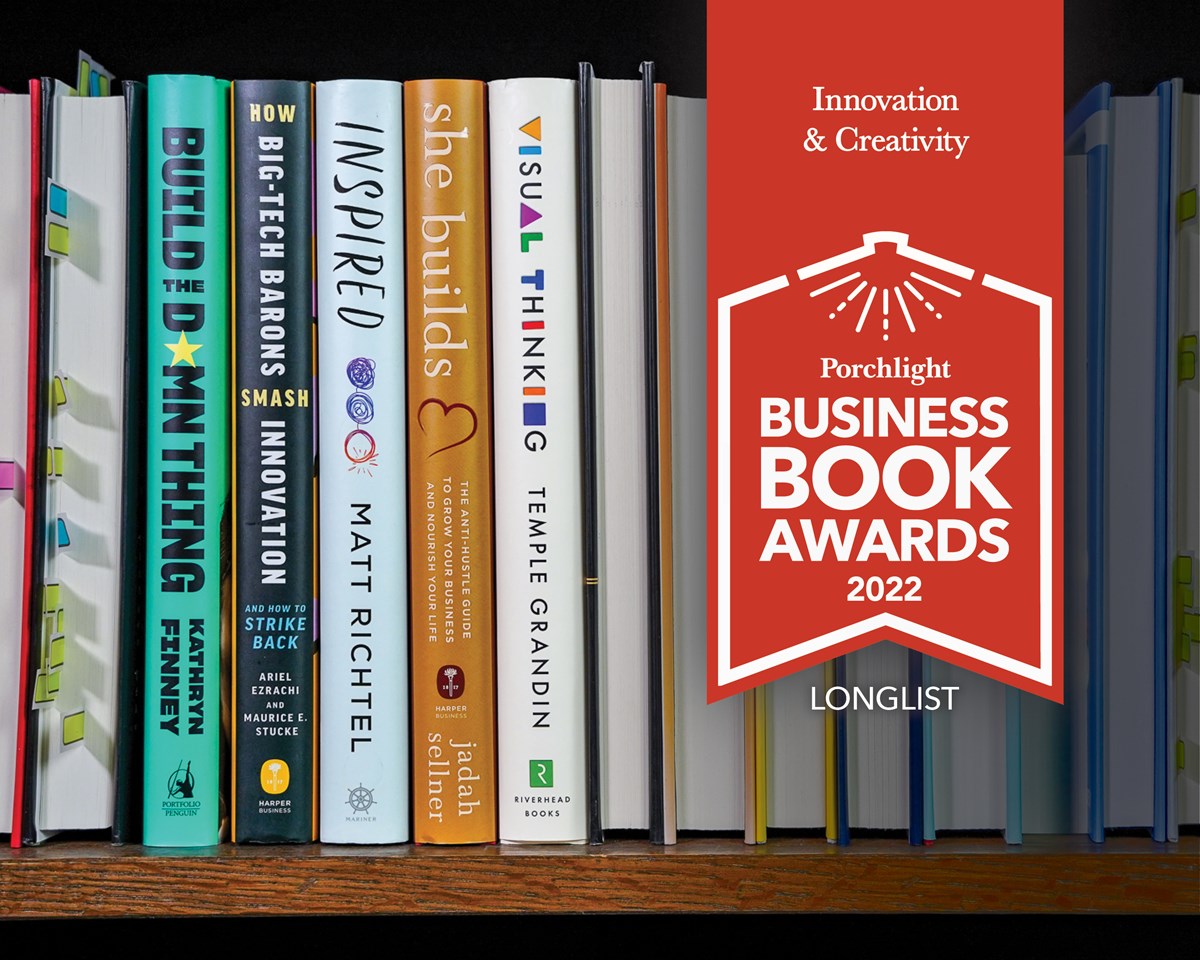
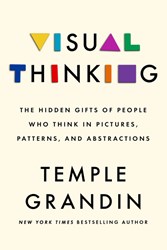 Visual Thinking: The Hidden Gifts of People Who Think in Pictures, Patterns, and Abstractions by Temple Grandin, Riverhead Books
Visual Thinking: The Hidden Gifts of People Who Think in Pictures, Patterns, and Abstractions by Temple Grandin, Riverhead Books
Language is a complex, ever-evolving system of communication that is so deeply embedded in our daily lives that it is hard to imagine a day, or even an hour, without words: hearing them, speaking them, thinking them, writing them, reading them. But scientist, academic, and animal behaviorist Temple Grandin makes clear in Visual Thinking that words are not everything to everyone.
Since her 1995 memoir Thinking in Pictures, Grandin has written books that continue to expand her own and others’ knowledge of autistic and neurodiverse individuals’ brains. It’s exciting to see the evolution of this understanding in her latest book, which opens us up to numerous forms of information processing. Thinking outside of language shouldn’t be too much of a stretch in the highly visual environments we live in nowadays, both online and off. Grandin even likens her visual thinking to “scrolling through Google images or watching the short videos on Instagram or TikTok.” And yet, as Grandin unpacks in Visual Thinking, the American education system and the narrow breadth of thinking it encourages (or rather the many varieties of learning and thinking that it fails to embrace) devalues arts and hands-on classes like home economics or shop class and removes opportunities for visual thinkers to succeed at a time it should be creating more of them. Grandin sees the consequences of visual thinkers being screened out of the education system in her work inspecting poultry and pork-processing plants, where little of the new machinery being used is invented and manufactured in the United States. This might also affect the number of students who can pursue careers as surgeons:
Dr. Maria Siemionow, a transplant surgeon at the University of Illinois, has trained many surgeons. She credits their dexterity to hands-on activities in their early years. But lots of kids no longer have experience working with their hands.
Before you begin imagining a world with surgeons who are bad with scissors, let’s move on to detailing the benefits that neurodiverse individuals bring to a company. In “recognizing what we gain by harnessing the power of every kind of mind,” Grandin suggests companies many need to alter their hiring processes to avoid screening out those who are bad at interviewing or lack interpersonal skills but bring other talents to the table. Visual Thinking is a thorough survey and passionate portrayal of visual thinking. It’s a book that covers a lot of ground on a still evolving but vital subject, and Grandin helps readers understand neurodiversity through both her personal experience and a variety of other real-world examples.
It’s very exciting to have a book like this that one can recommend to parents and managers, government employees and entrepreneurs, architects and engineers alike. It is a good reminder that we all need to understand how others understand the world, and we all need to make space in our days for quiet space to observe and to process it.
I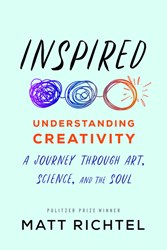 nspired: Understanding Creativity: A Journey Through Art, Science, and the Soul by Matt Richtel, Mariner Books
nspired: Understanding Creativity: A Journey Through Art, Science, and the Soul by Matt Richtel, Mariner Books
I'll introduce you to this book jumping right to the end, which highlights a very close-to-home instance of creativity: the COVID-19 virus and the vaccine created to combat it. Viruses themselves are creative geniuses, multiplying and mutating to find ways to survive. In turn, those who create vaccines must be even more creative, resulting in a survival built on “the escalation of creativity, with ever more refinements.” "A basic attribute of creators,” writes Richtel, “is not the initial quality of their ideas but the sheer quantity of mutation.”
Throughout Inspired, author Matt Richtel looks realistically at how creativity evolves across industries and across time, and how it is tied to our humanity. What it clearly shows is that creativity cannot exist in a vacuum. Creative ideas and humans are built on the shoulders of the generations that have come before them, and their characteristics depend on adapting to the conditions of their environment. Creative individuals depend on being connected with their communities, but they also depend on internal review and rest, and Richtel’s examples do an excellent job of illustrating these connections in everyday life and real-world examples—from the evolution of religion in the world to one guitarist's evolution to providing lessons online.
Richtel interviews people with a variety of interests and accomplishments whose occupational descriptions are frankly too complex to summarize in a few words. And that’s the mark of a true artist or entrepreneur: that one’s interests and accomplishments cannot be confined to one or two words like “zookeeper” or “singer” or “inventor of Velcro” without misunderstanding or misrepresenting their creative output or contribution to the world. And the truth is that this could be applied to most of us.
Inspired is a convincing and encouraging book that shows how, across the world and across time, the most fulfilling creativity occurs when we tap into our most true and complete selves without needing to put ourselves into specific creative categories or allowing others to do so.
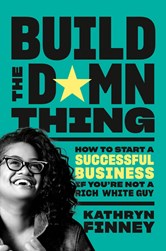 Build the Damn Thing: How to Start a Successful Business If You're Not a Rich White Guy by Kathryn Finney, Portfolio
Build the Damn Thing: How to Start a Successful Business If You're Not a Rich White Guy by Kathryn Finney, Portfolio
“I’m NOT okay with blogs, tweets, and business books spreading the gospel of the world of startups while hiding the fact that the rules are different for people like us.” So says serial entrepreneur and author Kathryn Finney. Build the Damn Thing is one of the most refreshing, realistic, thorough, and lively instruction manuals to entrepreneurship that I’ve ever come across, and I’m so excited to hear about the large crop of innovators that the book aids and inspires in the years to come.
Finney illustrates the slow-moving progress of equality in our society through the story of her own family. Her father came up in 1960s Milwaukee, “a straight-A student at a racially mixed high school.” But when he told his guidance counselor that he wanted to be a surgeon, the counselor suggested that it was an unattainable goal and that he should learn a trade instead. Even today, 60 years later, it wouldn’t be uncommon to hear this same advice echoed to someone less privileged in our community, but it is wrong, and strong, smart, and uplifting voices like Finney’s can spur us all to better support the underestimated members of our communities. And (spoiler alert) by taking risks—and having a family that allowed and even encouraged him to do so—Finney’s father became a senior engineer at Microsoft in 1993. As you read Build the Damn Thing, you’ll find that high ambition and high achievement runs in Finney’s family, and that business success is attainable for anyone. Finney effortlessly guides readers through mentally preparing to build their companies, defining and refining their ideas, assessing and reaching product-market fit, managing employees, and specifics on taking (or not taking) funding. She animates these decisions and directions with a voice of true love and passion for the entrepreneurial community. Epigraphs at the beginning of chapters are typical elements of business books, but the specific women and quotes that Finney highlights—from Lizzo to Michelle Obama to Mariah Carey in Glitter—made me smile every time. They provide a unique and delightful array of entrepreneurial examples.
Artists and entrepreneurs are known for their creativity and unique perspectives, but what I like most about Kathryn Finney and fellow longlister Jadah Sellner (up next) is that their experiences reflect those of people who don’t get to feel seen in the business space as often. Finney’s work on this front extends beyond the book: she founded an investment firm in 2020, Genius Guild, which supports diverse and community-focused entrepreneurs; the same year, she founded The Doonie Fund, to help other Black women entrepreneurs’ businesses survive the pandemic. After learning about and from Finney, it’s hard not to feel totally supported and inspired to build something of our own.
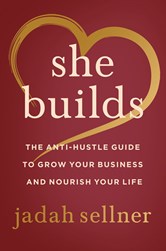 She Builds: The Anti-Hustle Guide to Grow Your Business and Nourish Your Life by Jadah Sellner, Harper Business
She Builds: The Anti-Hustle Guide to Grow Your Business and Nourish Your Life by Jadah Sellner, Harper Business
The topic of burnout has come up a lot, especially since 2020 when we collapsed our work lives and home lives into one static space. For women with families, it is especially stressful. In contrast to Build the Damn Thing, which is a map through entrepreneurship, Jadah Sellner’s She Builds offers a place to rest when you need to hit pause on your current career path and re-evaluate. In this, Sellner asserts:
Ultimately, being a woman in business is your superpower, not your weakness. Stepping into the next level of leadership requires a new way of thinking and being. How can you build a life in a way that works for you?” After all, what’s the point of being your own boss if you just keep bossing yourself around to work too hard?
It was in reading She Builds that it became totally clear to me how the productivity we use to feel better about ourselves is actually making us feel worse. Sellner shows how we can still succeed in business while acknowledging our limits, enjoying free time, and not putting all of ourselves into our work.
Sellner shares vulnerable moments in her personal and professional life—a fight with her husband/business partner over the financial stress of their daycare business, a deadline stress-induced fever that kept her from enjoying the holidays, and falling out of love with the health and nutrition business she built, to name just a few. The benefits of running one’s own business should outweigh the struggles, but the culture of hustle in entrepreneurship has been one that establishes constant struggle as the norm. Books like She Builds will help us all make business more humane.
Sellner emboldens entrepreneurs to fight for and work toward their dreams while also being present for other people and activities in their lives. She emphasizes balancing business goals with personal growth goals and making it all a sustainable practice. She tackles toxic productivity, defines the dangerous differences between being driven by harmonious passion vs. obsessive passion, and balances the smaller details and the big picture by asking us to think hard about complex questions like: What do you want to learn from your business? How do you want to serve your community? What is your future vision for yourself?
She Builds is a grounding book for entrepreneurs ready to go against the flow of our fast-paced world. With plenty of the author’s upbeat personality and a variety of case studies from big businesses like Canva, but mostly smaller entrepreneurs that Sellner has coached, She Builds offers clear guidance that doesn’t tell us what to do but rather encourages us to think more strategically and sustainably about what we are doing. Sellner convinces us “Stepping back isn’t a failure, it’s a strategy.”
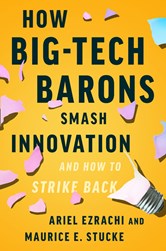 How Big-Tech Barons Smash Innovation—and How to Strike Back by Ariel Ezrachi and Maurice E.Stucke, Harper Business
How Big-Tech Barons Smash Innovation—and How to Strike Back by Ariel Ezrachi and Maurice E.Stucke, Harper Business
Now that you’ve been inspired by four generally uplifting innovators, you will be strong enough to confront the forces threatening innovation, entrepreneurship, and our wellbeing online. Since the early 2000s, Ariel Ezrachi’s and Maurice E. Stucke’s scholarly research on the digital economy, competition and antitrust law, and economic inequality have made waves in the policy debate space. They bring this expertise to a general audience in How Big-Tech Barons Smash Innovation—and How to Strike Back.
While Matt Richtel in Inspired provides a generally positive perspective on the community-building credentials of the internet, Ezrachi and Stucke expose how Big Tech’s influence on our user experience is censoring competitive innovators. The “Tech Barons” they analyze—Google, Apple, Meta, Amazon, and Microsoft—accounted for 25% of the S&P 500’s market capitalization in 2021, monopolizing the tech market and gaining control over the innovation ecosystem that is the internet. And it’s impossible to compete with these companies because:
Competing means more than being online. It means having a compelling presence, scale, customer base, and innovative products. It means companies re-engineering themselves into AI-centric firms, where the underlying data pipeline helps train and improve the algorithms, which drive many of the companies’ critical functions–everything from setting prices to personalizing services to predicting behavior.
The simple act of being on social media as a business feels like a daily fight for attention. And more and more it feels like a losing game where the only way to get ahead is to give more time and money to the Big Tech overlords.
I’m so appreciative of Ezrachi and Stucke’s work in antitrust law and for sharing their insight so approachably at such a pivotal time, when so many of us feel burnt out from living online during the pandemic. The digital world has been changing so rapidly, but their proposals for the way forward are promising. Their book is a wide-angle look at where we are, and who and what we—as small businesses and everyday internet users—are up against. And if more people read How Big-Tech Barons Smash Innovation—and How to Strike Back I think it will enable more fertile ground for truly helpful and humane innovation, online and off.








